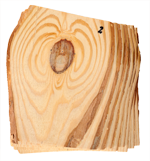|
HOW TECH TICKS |
|
|
|
|
|
Far below the big-picture view of the grand enterprise that is Virginia Tech, the education of individual students moves forward incrementally.
Sometimes the learning is tied up in knots. From various corners of campus, the people who know knots have much to share.
|
|
|
|
|
|
|
|
|
|
|
Knot: Clove-hitch knot |
|
Use: Mist nets |
|
The knot in action: In the College of Natural Resources and Environment's (CNRE) Conservation Management Institute, Mike St. Germain deploys mist nets to capture and study birds and bats. To tighten the nets, he slides a clove-hitch knot up the pole. "To increase tension, it's simple geometry," St. Germain said. |
|
|
|
 |
|
|
|
Knot: Double fisherman's loop, overhand knot, Schwabisch knot |
|
Use: Arboriculture |
|
The knot in action: Elsewhere in CNRE, urban forestry students have their heads in the clouds—and rightly so. To inspect, research, and maintain trees, arborists need a bird's-eye view. At the beginning of the semester, an arboriculture course (right) sent students into the trees with the help of a variety of knots. The overhand knot keeps the double fisherman's loop from unrolling, while the Schwabisch knot provides rope-grabbing friction. |
|
|
|
|
|
 |
|
|
|
Knot: Loblolly pine |
|
Use: In lumber, knots reduce the lumber’s grade and value. |
|
The knot in action: University Distinguished Professor Harold Burkhart developed a mathematical model of knot shape and volume in loblolly pine trees. Knowing the quantity, locations, and sizes of branches, the CNRE professor can estimate where the knots reside, thereby estimating the wood’s grade and value. |
|
|
|
 |
|
Knot: Tom fool's knot |
|
Use: Animal restraint, Virginia-Maryland Regional College of Veterinary Medicine |
|
The knot in action: At a bovine restraint laboratory in late August, veterinary medicine students practiced casting cattle, or bringing them to the ground, using ropes and tom fool's knots. The middle of a thick rope was draped across a cow's neck; and the rope's two ends were draped under the front legs, over the back, and underneath the hind legs. Then, the students pulled, four at a time, tug-of-war style, until the cow lay down. The tom's fool knots are used to secure the front and rear limbs to a fixed object, which allows a veterinarian to perform surgery on the animal. |
|
|
|
|
|
|
|
|
Knot: Slip knot |
|
Use: Crocheting—and now, architecture |
|
The knot in action: To learn the modeling software architects use, Alexander Worden (master of architecture '11) taught himself to crochet. Why? No longer are architects modeling with tangible forms, but with computer-based, curvilinear forms that react to each other. While studying real forms, Worden found in a lace doily a physical example of how digital forms can warp without tearing. "As you pull [a crocheting piece] and stretch it, the knots reconfigure and transform into a different system." He was immediately hooked and is one of only a few people worldwide who have applied crocheting knots to architecture. One of Worden's digital renderings appears at left. |
|
|
|
|
|
|
|
|
|
|
|
|
|
|
Knot: Square knot, butterfly coil |
|
Use: Rappelling, Corps of Cadets |
|
The knot in action: In the Corps of Cadets, rappelling is all about the knots. A bowline knot anchors the end of the rope, a square knot (above) connects ropes of equal diameter while under tension, a two-loop figure-eight knot forms two adjustable fixed loops, and a butterfly coil (modeled by Landon Perez, a construction engineering and management major) readies the rope for carrying. |
|
|
|
|
|

